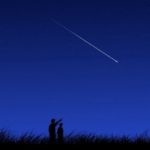By Saundra McBrearty, Outreach and Volunteer Specialist
 The peak of the Lyrid Meteor Shower will happen on Earth Day, April 22, 2020. We will also be blessed with a new moon, which potentially makes dark sky viewing on this night especially fantastic! Hope for a clear, cloudless sky, get away from city lights, and park yourself somewhere with a wide-open view of the night sky. If conditions are good, you will have a shot at seeing about 15-20 “shooting stars” per hour. You don’t need any special equipment to see meteors and you can still practice physical distancing. Simply lie back and look up at the dark sky, get comfortable with a lawn chair and blanket, be patient and enjoy the show.
The peak of the Lyrid Meteor Shower will happen on Earth Day, April 22, 2020. We will also be blessed with a new moon, which potentially makes dark sky viewing on this night especially fantastic! Hope for a clear, cloudless sky, get away from city lights, and park yourself somewhere with a wide-open view of the night sky. If conditions are good, you will have a shot at seeing about 15-20 “shooting stars” per hour. You don’t need any special equipment to see meteors and you can still practice physical distancing. Simply lie back and look up at the dark sky, get comfortable with a lawn chair and blanket, be patient and enjoy the show.
Although the peak of the shower is on April 22, you can view the shooting stars of the Lyrid Meteor Shower any night between April 16 – 25. As with most meteor showers, peak viewing is after midnight and before dawn. The radiant, the point from which meteors appear to originate, will be high in the sky in the constellation Lyra, to the northeast of the bright star Vega. Vega, along with the stars Deneb and Altair make up the summer triangle constellation. These constellations and others are fun to find, but don’t fixate directly towards the radiant because you might miss the meteors with the longest trails. Remember you want a wide, open view of the dark sky.
Lyrid meteors are one of the oldest recorded meteor showers, with observations dating back to 687 B.C. Lyrid meteors are pieces of debris from the comet Thatcher, a long-period comet that orbits our sun once every 415 years. Meteor showers occur when Earth crosses the orbital path of a comet, colliding with a trail of comet debris. As the debris burns up in the Earth’s atmosphere, the meteors leave bright streaks in the sky commonly referred to as a shooting star. Pieces of debris left in the comet’s path make an appearance on Earth every year. The Comet Thatcher itself had its perihelion, the most recent approach to the sun, in 1861. And Thatcher’s elliptical orbit won’t circle near Earth again until 2276.
Enjoy these two videos to learn more about the Lyrid Meteor Shower and meteor watching. Happy Earth Day and Night!







